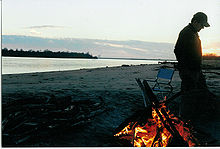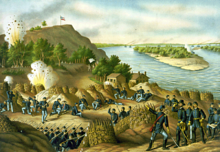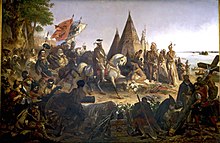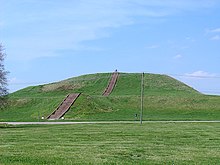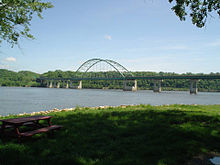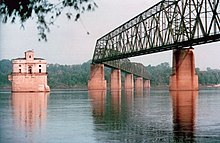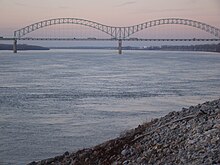- Bemidji, Minnesota
- Grand Rapids, Minnesota
- Jacobson, Minnesota
- Palisade, Minnesota
- Aitkin, Minnesota
- Riverton, Minnesota
- Brainerd, Minnesota
- Fort Ripley, Minnesota
- Little Falls, Minnesota
- Sartell, Minnesota
- St. Cloud, Minnesota
- Coon Rapids, Minnesota
- Monticello, Minnesota
- Minneapolis, Minnesota
- Saint Paul, Minnesota
- Nininger, Minnesota
- Hastings, Minnesota
- Prescott, Wisconsin
- Prairie Island, Minnesota
- Diamond Bluff, Wisconsin
- Red Wing, Minnesota
- Hager City, Wisconsin
- Maiden Rock, Wisconsin
- Stockholm, Wisconsin
- Lake City, Minnesota
- Maple Springs, Minnesota
- Camp Lacupolis, Minnesota
- Pepin, Wisconsin
- Reads Landing, Minnesota
- Wabasha, Minnesota
- Nelson, Wisconsin
- Alma, Wisconsin
- Buffalo City, Wisconsin
- Weaver, Minnesota
- Minneiska, Minnesota
- Fountain City, Wisconsin
- Winona, Minnesota
- Homer, Minnesota
| - Trempealeau, Wisconsin
- Dakota, Minnesota
- Dresbach, Minnesota
- La Crescent, Minnesota
- La Crosse, Wisconsin
- Brownsville, Minnesota
- Stoddard, Wisconsin
- Genoa, Wisconsin
- Victory, Wisconsin
- Potosi, Wisconsin
- De Soto, Wisconsin
- Preston, Iowa
- Lansing, Iowa
- Ferryville, Wisconsin
- Lynxville, Wisconsin
- Prairie du Chien, Wisconsin
- Marquette, Iowa
- McGregor, Iowa
- Wyalusing, Wisconsin
- Guttenberg, Iowa
- Cassville, Wisconsin
- Dubuque, Iowa
- Galena, Illinois
- Bellevue, Iowa
- Savanna, Illinois
- Sabula, Iowa
- Fulton, Illinois
- Clinton, Iowa
- Cordova, Illinois
- LeClaire, Iowa
- Bettendorf, Iowa
- East Moline, Illinois
- Moline, Illinois
- Davenport, Iowa
- Rock Island, Illinois
- Buffalo, Iowa
- Muscatine, Iowa
- New Boston, Illinois
- Keithsburg, Illinois
- Oquawka, Illinois
- Burlington, Iowa
- Dallas City, Illinois
- Fort Madison, Iowa
- Nauvoo, Illinois
- Keokuk, Iowa
| - Warsaw, Illinois
- Quincy, Illinois
- Hannibal, Missouri
- Louisiana, Missouri
- Clarksville, Missouri
- Portage Des Sioux, Missouri
- Alton, Illinois
- St. Louis, Missouri
- Ste. Genevieve, Missouri
- Kaskaskia, Illinois
- Chester, Illinois
- Grand Tower, Illinois
- Cape Girardeau, Missouri
- Thebes, Illinois
- Commerce, Missouri
- Cairo, Illinois
- Wickliffe, Kentucky
- Columbus, Kentucky
- Hickman, Kentucky
- New Madrid, Missouri
- Tiptonville, Tennessee
- Caruthersville, Missouri
- Osceola, Arkansas
- Reverie, Tennessee
- Memphis, Tennessee
- West Memphis, Arkansas
- Tunica, Mississippi
- Helena-West Helena, Arkansas
- Napoleon, Arkansas (historical)
- Arkansas City, Arkansas
- Greenville, Mississippi
- Vicksburg, Mississippi
- Waterproof, Louisiana
- Natchez, Mississippi
- Morganza, Louisiana
- St. Francisville, Louisiana
- New Roads, Louisiana
- Baton Rouge, Louisiana
- Donaldsonville, Louisiana
- Lutcher, Louisiana
- New Orleans, Louisiana
- Pilottown, Louisiana
- La Balize, Louisiana (historical)
|
 The Jefferson River is a tributary of the Missouri River, approximately 77 miles (124 km) long, in the U.S. state of Montana.
The Jefferson River is a tributary of the Missouri River, approximately 77 miles (124 km) long, in the U.S. state of Montana.










